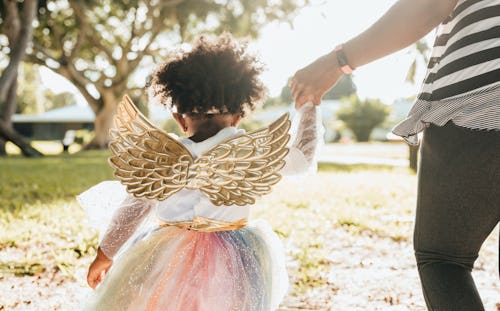
Halloween costume shopping is an exciting part of preparing for the spooky season, but it can be a daunting and anxiety-inducing ordeal for kids with sensory sensitivities. Aggravating accessories and uncomfortable designs can taint the experience, causing stress and apprehension to fill the weeks leading up to the big day. And everybody deserves to have a happy Halloween.
So, I reached out to Julia DeNey, the fashion designer behind Sense-ational You, a clothing brand that offers sensory-friendly clothing for children with autism or sensory-processing disorders. She shared her best tips with me to ease the costume selection process, promote inclusivity, and ensure children have a sensory-friendly and enjoyable holiday.
Involving Children in Planning
Before costume shopping ever begins, have a conversation with your child to understand their preferences. "Going to the store might be overwhelming, but showing them some options online at home could be more comfortable," says DeNey. She offers that parents can also go to the store and get a few options to feel and try comfortably at home (but first, make sure they are returnable!).
If trying on costumes is overwhelming, let them familiarize themselves by touching and wearing them multiple times before Halloween. Offering choices can ease anxiety and make it fun for you and your child, but don't overload them with too many options or open-ended questions. "You know your child best, so ask their opinion and involve them in every step of the process," she says.
All About the Fabric
Start by determining the most suitable material for your child's unique needs and preferences. DeNay recommends comfortable, breathable fabrics such as cotton jersey, sweatshirt fleece, and other natural fiber knit fabrics. "Be cautious of fabrics that make a swishy noise when they move," she says. Synthetic materials can also cause overheating, producing sweat and irritating the skin.
Attention to detail for the costume's inside is as important as the outside. Opt for easily removable tags and minimal seams, with flat seams inside. Steer clear of anything overly constrictive or limiting in terms of movement. Remember, allowing them to move freely is essential.
DeNey adds that it's crucial to consider anything that interferes with their favorite stims. "For example, if they love stimming with their fingers, don't buy a costume that requires mittens," she says.
Modifying for Comfort
You've scored the perfect costume for your kid's size, and it didn't break the bank — but those tags are a nightmare, or there's some other problem. DeNey advises sprucing up store-bought outfits: Use a seam ripper, which is much less likely to put a hole in the costume. Just pull out the stitches holding the tag in place, and voila, it's like they never existed.
To tackle those annoying closures and seams, consider having your kiddo sport a comfortable layer underneath so it's not rubbing directly against their skin. Plus, wearing a backup layer beneath the costume lets them bail out whenever they're not feeling it. There's no need to leave the spot for a costume change.
How to Accessorize
Sometimes, the accessories can make or break a costume, but many can wreak havoc on a child's nervous system, setting them up for a frustrating and distracting trick-or-treating night. DeNey recommends limiting accessories to what your child can tolerate or even skipping them altogether. Opt for soft accessories like no-pressure headbands, decorative hoods, and soft hats if necessary. Skip items like masks, headpieces, and capes that fasten around the neck, as they may cause discomfort or distress.
Facepaint can be an expressive and suitable alternative to masks or headgear. DeNey adds that a great substitute for a superhero cape is a -shirt with that superhero's logo on it. "If they like tattoos, they can also get various tattoos on them of that superhero. You can even buy paper for your printer to print any design you want and then iron it onto any fabric."
Preparing for Parties and the Big Night Ahead
Once the particulars of costuming itself are ironed out, it's just as important to prepare for the main activity. Your kid is dressed for a successful night out or their school celebration, but how can you support their experience to be a positive one?
During trick-or-treating, respect their comfort zone by not forcing them to approach doors they're uncomfortable with. Offer alternatives like holding a friend or family member's hand to ask for candy or even going up to the door on their behalf if they're excited about the treats. Consider just walking around the neighborhood if traditional trick-or-treating isn't their thing. "Make sure they are also prepared ahead of time so they know what to expect in the evening," DeNey says. "You can even make a visual schedule specific to that night and/or bring a timer if that strategy works for them."
For school or community celebrations, in addition to door-to-door candy missions, bring any sensory supports like sound-reducing headphones, favorite fidgets, weighted or compression vests, or garments. "Anything they love that helps them regulate will be important, as Halloween can be very overstimulating," says DeNey.
It's perfectly OK if your child doesn't want to wear a costume or participate fully in Halloween activities. Respect their choice and comfort level. You can offer your presence as a source of comfort and support, "Ask if you can be there. Your comforting presence might really help them. You could hold their hand in the parade or sit with them at the party, and that way, you can always leave with them at any point."



0 Comments